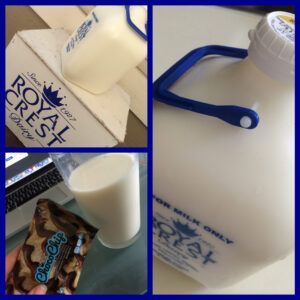Milk – It does a body good! Or not?
I was recently sitting down with a colleague who is consistently doing tons of research (I love that about her!) and well on her way to ridiculously awesome health.
I admire the ginormous amounts of information she has unearthed and learned. Yet, there was one thing that left me unsure about one of my favorite food groups…. dairy. More specifically – milk. I LOVE my Royal Crest milk and, quite frankly, wouldn’t want to live without it. [That might be exaggerating it but what would a post be without a little exaggeration?]
The school of thought is that low-fat milk is more processed then whole-milk. “Whole” implies “untouched”… right? Therefore, we should purchase whole-milk and dilute it with water (reverse osmosis of course) instead of simply purchasing 1% (1% is what I recommend to my clients). To be perfectly honest, I wasn’t entirely sure of the milk manufacturing process… so I’ve done a little research.
What I uncovered:
Whole milk is no less processed then any other percentage milk.
So what is the milk-making-process anyway?
- Collection. All raw milk is collected in large containers and transferred to the manufacturing plant
- Separation. Milk is then run through a clarifier/separator – which removes debris, bacteria and sediment, as well as, separates the heavier milk fat.
- Fortifying. Yep – ALL milk goes through a fortifying process for Vitamins A and D.
- Pasteurizing. Yep – ALL milk goes through a heat process of killing the bacteria called pasteurizing.
- Homogenizing. Most milk goes through this process. This process basically ensures the milk does not separate. Have you seen whole milk off the shelf (organic or not) separated? If not, then it went through this process.
- Packaging. All milk is packaged somehow – coated container, glass, or plastic. To be delivered to your shopping center.
- Cleaning. Did you know that processing equipment and piping systems are cleaned once a day? Good to know!
To sums things up, I love what this article had to say: I don’t mean to suggest that milk is bad or any less nutritious because it’s been processed. But, let’s be clear, it is a processed food. The white stuff that comes out of a plastic jug is undoubtedly physically changed and compositionally altered from the white stuff that flows forth from a cow’s udder. As for the question as to whether whole milk is any more “natural” than skimmed or part-skimmed milk, the answer is a definitive NO.
 Unless you get your milk directly from the farmer, just out of the cow (is that even possible unless you own the cow?) here’s what I would say…
Unless you get your milk directly from the farmer, just out of the cow (is that even possible unless you own the cow?) here’s what I would say…
-
I recommend hitting up a local dairy provider that will deliver hormone free milk.
-
I recommend 1% (you need a little fat to help the body process the natural sugar found in milk).





